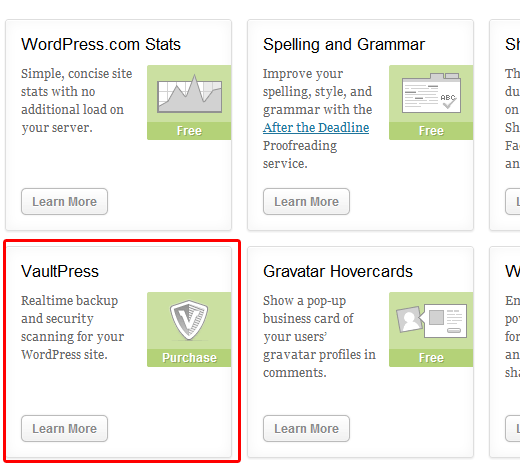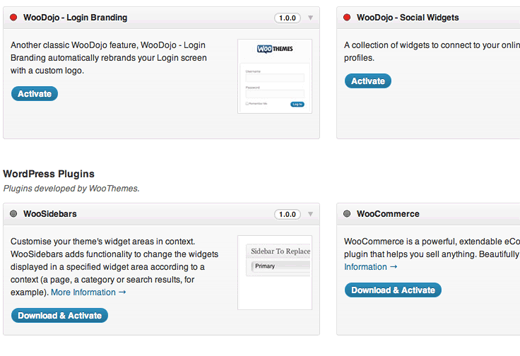Up until recently, product placement in free WordPress plugins has always been a challenging task. We have seen numerous methods utilized by developers. Some included banner ads on the plugin options page, others released “lite” versions of the plugins, some used lightbox popups in the backend to promote, but none of those methods were as appealing as the one we see emerging. It was first done by Automattic in their Jetpack plugin, and now WooThemes is following the lead with their newest creation called WooDojo. Since there is no name for this product placement model, we will take the liberty of calling it “The Teaser Model”. You are probably wondering what is this Teaser Model? Basically the teaser model allows you to list a bunch of features into one big dashboard where you can simply activate the ones you want. However, some features in the list will be commercial. So you see what the options does, but you have to pay to get it.
The most interesting aspect of “The Teaser Model” is that it is a really creative way for commercial plugins to enter the WordPress plugins repository. Note: Commercial plugins are NOT allowed in the plugin repository (and unlike commercial themes, there is no commercial plugins listing on WordPress.org).
So let’s take a look at exactly what this “Teaser Model” entails and how this can be abused.
We will use Jetpack as an example case-study. So when you first activate Jetpack (a FREE plugin), it does NOT work right off the bat. You MUST have a WordPress.com account for it to work. So when you access the Jetpack screen, you will see a list of all available features. In between a bunch of FREE options, there is VaultPress (a paid plugin promo).

It is important to note, that we have nothing against VaultPress. As a matter of fact, we use it on our sites. So basically, once you connect to WordPress.com all other features will become available except for VaultPress (Because you have to buy it).
We noticed this a while ago and thought this was creative. But recently with the launch of WooDojo, we think this idea has potential of becoming the next trend. Here is a look at how Woo is doing their product placement:

Now while they are only promoting their other FREE plugins, this idea has potential. We wouldn’t be surprised if WooCommerce (that has a good number of paid extensions) actually adapt the widget style look for their backend (up-selling the PAID extensions).
So you are wondering how this model could be abused creatively? Basically any PAID plugin can use this model to work their way into the repository, get new user-registration (emails etc), and up-sell their paid products.
Anyone can simply require users to “Connect” with their site. Connecting would mean the user MUST create an account (free account, but you can upsell the paid options on the membership page). Even if it is a FREE account, you can STILL collect their emails. The user has no choice but to connect otherwise the plugin will not work. Once they have connected to your service, you can implement one-click buy/install features. Since you have their email address (because they are your user), you can use it to up-sell your new products.
Do you think this is the future of product placement in Free WordPress plugins? Would love to hear the community’s thoughts on this. It would also be interesting to see if more developers shift their development model this way. Rather than creating numerous small plugins, should they bundle all of their products into one place? This would also influx the count of downloads because often people might download the plugin just for one feature out of the many that it may offer. But the total download count will be significantly higher.





Otto
Jetpack is primarily a “serviceware” plugin. Most of the functionality in Jetpack requires actually talking to the WP.com servers to work (only exception is the embed shortcodes, I think). So the existence of a login/registration for that makes sense.
However, requiring login/registration just to “activate” a plugin, when the plugin itself is doing all the work, is not allowed in the WordPress.org repository. And yes, we do enforce that. See guideline #6 regarding how we define a “service”.
As to the larger question of upselling new features or advertising for your other plugins/products, well sure, that’s valid and always has been. It’s expected, actually. The donation model doesn’t work for all people, and if you sell products or “pro” versions of a plugin, then putting what is basically an ad for your wares into your free plugin is expected. We do frown on advertising other people’s stuff though, or adding affiliate marketing schemes and such. That’s just spammy. But selling yourself and your own services is pretty much the norm. Heck, even my plugins say “if you like this plugin, why not try my other plugin too?”. Nothing wrong with that.
kgjerstad
The Paypal donation buttons never worked. So why not promote your Premium stuff? Ethically, there’s nothing wrong with it. If devs abuse, they’ll loose their users.
A similar ethical question for WordPress related sites like this one: not disclosing that links to reviewed plugins, themes and services are affiliate links is a clear conflict of interest.
For example, the WooThemes link above in this article.
You would gain a lot more trust from readers if you simple stated it, like many others do, starting with Yoast.
wpbeginner
@kgjerstad We do have the disclosure: https://www.wpbeginner.com/wpbeginner-disclaimer/It pretty much states that any link you click on this site… simply assume that we are making money from it.
kgjerstad
@wpbeginner Right, I should have read the disclosure.
hesscj
You know, I was thinking of making a plugin with premium features and requiring registration and a code to get the premium features. It hadn’t occurred to me to force registration to get the basic features to work.
Turnon
At first maybe WP should ethink about the plug in directory. There will be always premium plugins , why not make a seperate directory for it ? If you can not beat them , join them.
The P3 plugin is a also a plugin with the same purpose sell webhosting (godaddy)
JDM
I wouldn’t say this is exactly a new model, but it’s pretty new to the WP plugins marketplace. Usually called a “Freemium”, or free plus a premium, plugin developers can have a single plugin to support and simply allow users to pay to enable features (some, all, none/free).